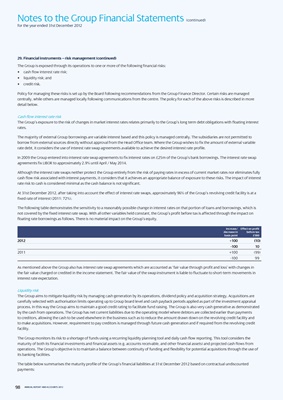
Notes to the Group Financial Statements (continued)
for the year ended 31st December 2012
29. Financial instruments – risk management (continued)
The Group is exposed through its operations to one or more of the following financial risks:
• cash flow interest rate risk;
• liquidity risk; and
• credit risk.
Policy for managing these risks is set up by the Board following recommendations from the Group Finance Director. Certain risks are managed
centrally, while others are managed locally following communications from the centre. The policy for each of the above risks is described in more
detail below.
Cash flow interest rate risk
The Group’s exposure to the risk of changes in market interest rates relates primarily to the Group’s long term debt obligations with floating interest
rates.
The majority of external Group borrowings are variable interest based and this policy is managed centrally. The subsidiaries are not permitted to
borrow from external sources directly without approval from the Head Office team. Where the Group wishes to fix the amount of external variable
rate debt, it considers the use of interest rate swap agreements available to achieve the desired interest rate profile.
In 2009 the Group entered into interest rate swap agreements to fix interest rates on £25m of the Group’s bank borrowings. The interest rate swap
agreements fix LIBOR to approximately 2.9% until April / May 2014.
Although the interest rate swaps neither protect the Group entirely from the risk of paying rates in excess of current market rates nor eliminates fully
cash flow risk associated with interest payments, it considers that it achieves an appropriate balance of exposure to these risks. The impact of interest
rate risk to cash is considered minimal as the cash balance is not significant.
At 31st December 2012, after taking into account the effect of interest rate swaps, approximately 96% of the Group’s revolving credit facility is at a
fixed rate of interest (2011: 72%).
The following table demonstrates the sensitivity to a reasonably possible change in interest rates on that portion of loans and borrowings, which is
not covered by the fixed interest rate swap. With all other variables held constant, the Group’s profit before tax is affected through the impact on
floating rate borrowings as follows. There is no material impact on the Group’s equity.
increase/ Effect on profit
decrease in before tax
basis point £’000
2012 +100 (10)
-100 10
2011 +100 (99)
-100 99
As mentioned above the Group also has interest rate swap agreements which are accounted as ‘fair value through profit and loss’ with changes in
the fair value charged or credited in the income statement. The fair value of the swap instrument is liable to fluctuate to short-term movements in
interest rate expectation.
Liquidity risk
The Group aims to mitigate liquidity risk by managing cash generation by its operations, dividend policy and acquisition strategy. Acquisitions are
carefully selected with authorisation limits operating up to Group board level and cash payback periods applied as part of the investment appraisal
process. In this way the Group aims to maintain a good credit rating to facilitate fund raising. The Group is also very cash generative as demonstrated
by the cash from operations. The Group has net current liabilities due to the operating model where debtors are collected earlier than payments
to creditors, allowing the cash to be used elsewhere in the business such as to reduce the amount drawn down on the revolving credit facility and
to make acquisitions. However, requirement to pay creditors is managed through future cash generation and if required from the revolving credit
facility.
The Group monitors its risk to a shortage of funds using a recurring liquidity planning tool and daily cash flow reporting. This tool considers the
maturity of both its financial investments and financial assets (e.g. accounts receivable, and other financial assets) and projected cash flows from
operations. The Group’s objective is to maintain a balance between continuity of funding and flexibility for potential acquisitions through the use of
its banking facilities.
The table below summarises the maturity profile of the Group’s financial liabilities at 31st December 2012 based on contractual undiscounted
payments:
98 ANNUAL REPORT AND ACCOUNTS 2012